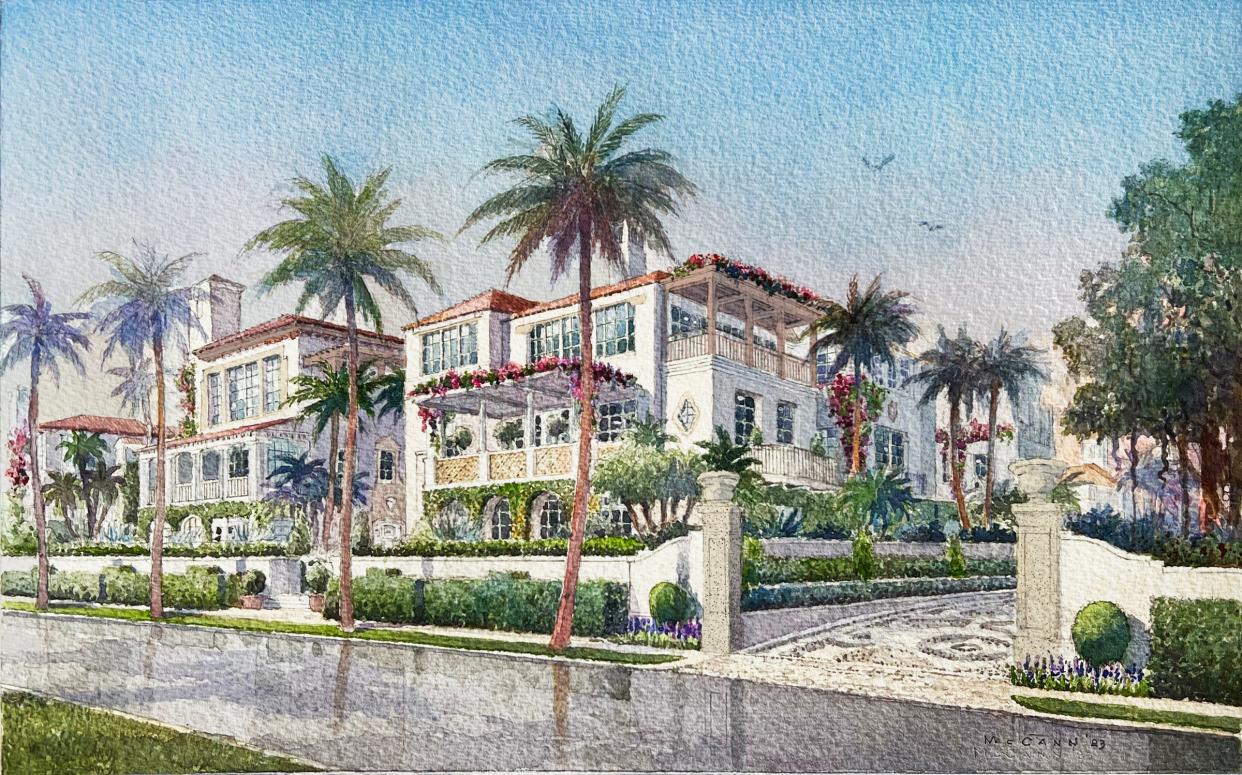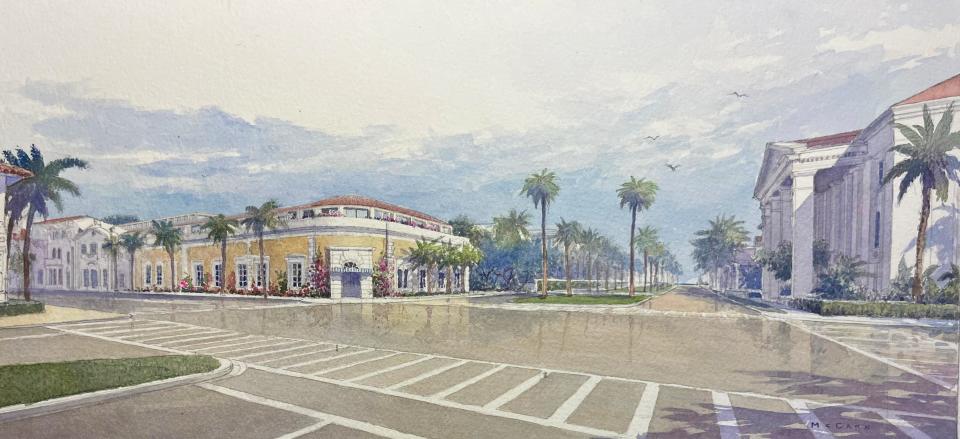Wells Fargo site development plan gets mixed reception from Palm Beach officials, residents

Dozens of residents attended Tuesday’s Town Council meeting to get a first look at preliminary plans for an extensive residential redevelopment project proposed for nearly 6 acres east of the landmarked Wells Fargo Bank Buildings on South County Road and Royal Palm Way in Mditown Palm Beach.
During the informal review, which ran for more than three hours, residents, officials and representatives of the project weighed the merits of a proposal to rezone the property and amend the town's comprehensive plan to accommodate the development. The review also dealt with issues regarding traffic, residential density and other issues.
The plan was both praised and criticized — but in the end, council members commended the project representatives and attendees for their civility during the review, which required no formal vote from the council.
“You all were so polite today. Sometimes it gets very nasty, and I just want to thank every side for being so kind to each other,” Council Member Julie Araskog said at the conclusion of the meeting.
The meeting was requested by representatives of Palm Beach-based Frisbie Group, who said they wanted to get feedback and recommendations from officials and residents before finalizing their plans for the project and submitting it to Town Hall for approval.
“It falls in the court of the applicant to determine how they may proceed, and if they do want to proceed, they will go over to P&Z (the Planning and Zoning Commission),” Town Attorney Joanne O’Connor told the council.
As presented, the project also would need win to approval from the Town Council — acting in its traditional role and as the Local Planning Agency — and the Landmarks Preservation Commission.
By the end of the meeting, council members appeared to agree that some of the buildings proposed for the site were too large and too tall. And the layout, they said, needed more breathing room.
"I appreciate what you are trying to do, but I think it needs to be scaled way back," Araskog said, addressing representatives of the Frisbie Group.
Frisbie Group: Project is far less intensive than current zoning allows
Coined the “East Plaza” project, Frisbie Group would redevelop the land, which Wells Fargo has said it plans to sell. In the mix is financial backer The Related Cos., the titanic real estate firm owned by Palm Beach billionaire and Miami Dolphins owner Stephen M. Ross.
The site is currently home to three parking lots behind a nearly-block-long stretch of buildings that include several landmarked structures along South County Road. The landmarked street-facing exteriors will be retained under the current proposal, as detailed in a website recently launched by Frisbie Group, EastPlazaPalmBeach.com.

Key to the proposed plan's fruition would be a comprehensive-plan amendment and zoning-code map changes. Currently, the site is divided into three zoning districts — one residential and two commercial.
Under the Frisbie Group's plan, the vast majority of the project would be redeveloped with single-family houses, townhouses and condominiums, with a total of 37 residences. Wells Fargo would be the sole commercial tenant on the site, once the two other tenants' leases expire.
"All in all, 70% of the subject property existing zoning, promotes commercial uses and intensities," said Rob Frisbie Jr., the project's representative, during Tuesday's meeting.
As currently zoned, a "realistic development" could be built that might include "retail, office, hotel (and) offices," he added.
'Planned unit development' designation a key to proposal
But Frisbie Group wants the council to replace the three zoning districts with a planned unit development, or PUD. Like a zoning district, a PUD sets out guidelines for what can be developed within its scope but defines more specific uses than traditional zoning rules.
Frisbie Group's Joshua Martin, a former director of the town's Planning, Zoning and Building Department, told the council that a PUD designation would be the most efficient way to develop the property. The designation would also eliminate requests for individual code variances and so-called "special exceptions," which would be hard to justify, given the size of the land, said Martin, who serves as an alternate member on the town's Architectural Commission.
The council, Martin added, would have strict control over what would be built under the PUD designation in terms of building use, height and scale.
"We're going to limit the (allowable) use — which no other PUD has done to this detail — to only single family residentials and the bank," he said. "No restaurants, no bars, no clubs, no coffee shops, no art galleries, nothing."
Martin also emphasized that the PUD would be "geographically tied" to the site, so that it could not be used for other development projects.
Under the PUD proposed by the Frisbie Group, the project would retain the square footage of buildable land while increasing the percentage for residential use to 83%. The square footage for commercial use would drop to just over 17%, which would be used to house Wells Fargo.
"We like to use the analogy we are utilizing the same amount of clay but molded in a more town-serving and thoughtful presentation," Frisbie said.
Proposal: 37 residences, including houses, condos and townhomes
On the north side of the property, just south of Seaview Avenue, the plan proposes two-story single-family detached residences similar in style to those found on neighboring streets.
In the center of the site, the project would have single-family residences at a height equivalent to two-and-a-half stories, with an opening in the center of the site for a garden space. Buildings on the south side of the property, facing Royal Palm Way, would feature three-story "flat typology" condominiums, Frisbie said.
The plan also proposes an underground parking structure, and a second- and third-story addition to the non-landmarked Wells Fargo building on the corner of South County Road and Royal Palm Way.
Frisbie said the architecture of the development would be influenced by Palm Beach's "Big Five" historic architects — Addison Mizner, Howard Major, Marion Sims Wyeth, Maurice Fatio and John Volk.
Moreover, according to Frisbie, the planned density for the site plan would be roughly seven units per acre. That's a reduction from the density allowed under current commercial zoning, which would allow a maximum of 26 residential units per acre, he said.
Council members ask: How much is too much?
At one point, Araskog asked Director of Planning, Zoning and Building Wayne Bergman if the proposed PUD would quality as an intensification of use of the property.
The Frisbie Group's plan would be an intensification, Bergman said, citing the third-floor additions, which are barred under current zoning.
Araskog also questioned whether a PUD is just a means for developers to build whatever they want on a property.
"I would push back a bit on the idea that simply by considering a PUD, (it would allow) the applicant to create the zoning district it deems fit," said O'Connor, responding to Araskog. "It's really up to you."
Council Member Lew Crampton said he viewed the PUD as a way for the town to create a zoning district in tandem with the developers.
He also asked Bergman if the project is an intensification in relation to what could be built there, the central argument made by Frisbie.
"That's correct," Bergman responded. "The commercial C-B zoning district to the south of the lot does allow for special exception uses, such as hotels, condo hotels and timeshares," said Bergman. "Those 'evil' commercial uses would be abandoned by this application."
But council President Margaret Zeidman made clear that even if there was a proposal for a hotel, the council, guided by the comprehensive plan, would have the final say about any construction on the site.
Council Member Bobbie Lindsay asked Frisbie about the expected square footage of the residences.
"The homes range from 3,500 square feet to 8,000 square feet, I'll say, to be safe," replied Frisbie.
His response elicited a wave of whispers and gasps from some members of the audience.
Residents divided in opposition, support
Residents who attended Tuesday's presentation were relatively split on the project's merits, although a noticeable portion of those who live on from neighboring Seaview Avenue expressed concern that the project would increase traffic in the surrounding area.
Even residents who opposed nearly all aspects of the project said they appreciated the Frisbie Group's proposal to develop a mostly residential project as opposed to the commercial uses allowed under current zoning.
Real estate agent and longtime resident Liza Pulitzer Calhoun criticized the proposed development, deeming it a high-density development. She also was critical of the three-story structures proposed.
She did however extend an olive branch to the Frisbie Group.
"If they can do something in a smaller scale, with all of those beautiful attributes they're proposing, I'm all in favor of that," she said, referring to the architectural design influences.
John Koch, president of the 100 Royal Palm Way condominium association, raised multiple concerns over the project, including the use of a PUD. His oceanfront building is just down the street from the bank site.
"We are fully opposed, in conclusion, to any new structure over two stories on the site. We are most concerned about the new traffic pattern using Royal Palm Way and the creation of new access points," he said. "Finally, the PUD zoning request is not acceptable unless a fixed and immutable plan can be implemented, as has been represented."
Others who spoke — including longtime resident Tina Fanjul, who owns a real estate agency, and Joan Goodman, who lives across town on North Ocean Boulevard — said they were wholeheartedly against the project. Goodman questioned how the Frisbie Group could have viable green space planted above the proposed underground parking garage.
Frisbie said the project would create a drainage system similar to the one at Via Flager by the Breakers, a Frisbie Group-developed property on Royal Poinciana Way.
Goodman was still skeptical: "I think everyone needs to go to Via Flagler and see what that looks like, because to me it was very disturbing. You can't promise something that won't be," she said.

But the project received strong support from other residents, including Code Enforcement Board member Martin Klein, a former chairman of the Planning and Zoning Commission.
"Good people putting forth tremendous effort in a reasoned way deserve our support," said Klein. "Change does come, and we need to manage it well, and I think this proposal does that."
Also supportive of the project was resident Paul Leone, who is CEO of The Breakers. The resort's parent company bought the ground-floor retail space and parking garage at the Via Flagler development from Frisbie Group.
"Wells Fargo is not going to sit on the parking lot for another 50 years. They put the property on market," Leone said. " if it's going to be developed, who better who better to develop it than the Frisbie Group, our neighbors with a track record? ... We could not ask for a better applicant."
Official: Size, location of the land means redevelopment is inevitable
During the council members' closing remarks, Araskog said she believed the project should not be pursued until the town completes a long-planned reform of its zoning code.
She added: "I'm not for a PUD, as of yet."
Zeidman, during her comments, pointed to the Wells Fargo ownership of what is considered highly sought-after property, thanks to is size and location.
"Wells (Fargo) owns it, they want to sell it, and they will sell it — and whoever owns it has the right to build on it, within the (restrictions of the) comprehensive plan and zoning code," she said.
She also called for a reduction in the overall building sizes and heights and the incorporation of more green space.
Adding more green space also was a priority for Council Member Ted Cooney.
Cooney who acknowledged that the land would surely be redeveloped at some point, said he remained "open to a PUD," calling the site one of the few locations in town where the zoning tool could be used successfully.
He described the proposal's raised elevation of the site — to address flood-plain concerns — as "forward thinking" but said the height of the buildings needed to be reduced to two floors above ground. Cooney also echoed public concerns over possible increased traffic intensity and a lack of specific information about how far the upper floors of the buildings would be set back.
"This is not the worst starting point it can be," said Cooney. "But if some of these things can be worked on and massaged ... I'm willing to entertain that."
Diego Diaz Lasa is a journalist at the Palm Beach Daily News, part of the USA TODAY Florida Network. You can reach him at dlasa@pbdailynews.com. Help support our journalism. Subscribe today.
This article originally appeared on Palm Beach Daily News: Major Palm Beach redevelopment plan at bank site gets mixed reception

